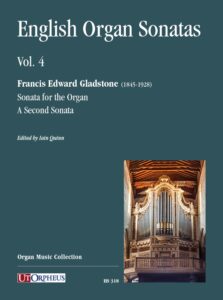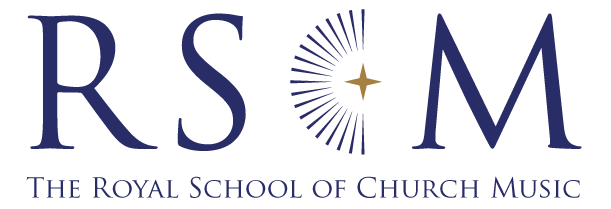Reviews of CDs
* Worth hearing
** Recommended
*** Essential listening
CHORAL CDs
**
RISE UP AND WONDER
Choir of Salford Cathedral / Alex Patterson ♦ Priory PRCD1249
This attractive recital, effectively a year’s worth of liturgical music, is of music by living female composers from Australia, the UK and Canada, with 12th-century Hildegard of Bingen being the obvious exception. June Nixon’s atmospheric Adam lay ybounden and Tasmin Jones’s bouncing, bubbly Tomorrow shall be my dancing day get the disc off to a great start. Salford Cathedral Choir performs with commitment: the singers capture effectively the varied characteristics of Becky McGlade’s Missa brevis and give an emotionally shattering account of Sarah MacDonald’s Crux fidelis. The repertoire is well chosen, accessible and appealing. Other composers include Eleanor Daley, Amy Summers, Sarah Quartel, Stephanie Martin, Lucy Walker, Gail Randall, Yshani Perinpanayagam and Judith Weir (her setting of William Blake’s My Guardian Angel). The two Hildegard of Bingen pieces (Laus Trinitati and O virtus Sapientiae) fit beautifully into the proceedings. The choir, singing a cappella throughout with wonderful blend and clear diction, is a worthy ambassador for these composers and works.
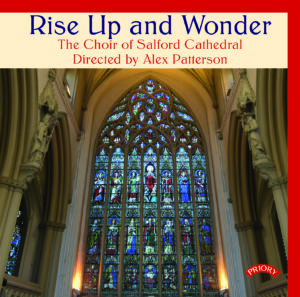
***
BACH & MACMILLAN: MOTETS & SACRED SONGS
Tenebrae / Nigel Short ♦ Signum Classics SIGCD773
This is an intriguing and delightful disc of music composed almost three hundred centuries apart by the Lutheran Johann Sebastian Bach and Catholic Sir James MacMillan. The small vocal forces (only 17 singers in total) allow Bach’s harmonic intricacies and polyphonic textures to weave beautifully, creating a sumptuously clear texture. Bach’s Komm, Jesu, komm (BWV 229), Jesu, meine Freude (BWV 227) and Singet dem Herrn (BWV 225) sit comfortably alongside MacMillan’s Tenebrae Responses, Miserere and I saw Eternity the other night. The tracks segue seamlessly from one to another, which makes for an effective listening experience. The emotional punch and dissonances of MacMillan’s Miserere seem to morph into Bach’s Jesu, meine Freude, and so on. The urgent, sharp dynamic contrasts of MacMillan’s Tradiderunt me (the second of the Tenebrae Responsories) and the intensity of his vision in I saw Eternity the other night make for an extremely moving listen.
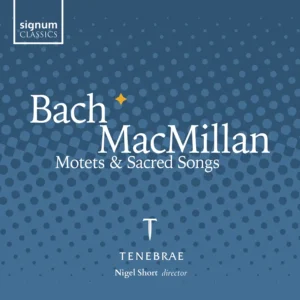
***
MIRABILIS: THE MUSIC OF STEPHEN HOUGH
London Choral Sinfonia / James Orford (organ) / Michael Waldron ♦ Orchid Classics ORC100256
Sir Stephen Hough may be a household name as a concert pianist, but in recent years he has turned his attention to writing and composing. This substantial disc documents his considerable choral output. A dramatic and atmospheric setting of Just as I am leads to his Missa Mirabilis, Londinium canticles for upper voices, and various Christmas carols with new music for the original words, including Ding Dong Merrily on High, Silent Night, Hark, the Herald Angels Sing and a setting of Rowan Williams’s Advent Calendar. James Orford performs the Sonatina for Organ and the disc closes with Danny Boy. The professional singers of the London Choral Sinfonia appear to have taken this music to heart. They convey the many moods of the Missa Mirabilis with great sensitivity, from rhythmically exciting Gloria to ethereal Agnus Dei. The Londinium Nunc dimittis is a work of immense beauty and receives a loving performance. Overall, it is a rewarding disc celebrating this most remarkable of polymaths.
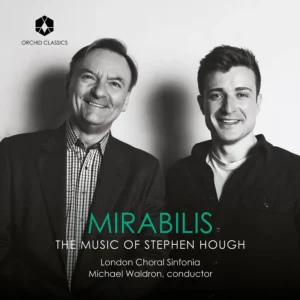
**
HEAVEN TO EARTH: JOANNA FORBES L’ESTRANGE
London Voices / Andreana Chan (organ) / Ben Parry ♦ Signum Classics SIGCD790
Joanna Forbes L’Estrange will be a familiar name to readers of CMQ, and many of the pieces on this beautiful album have been published by RSCM Publications. We are treated to sumptuous performances of the King’s College Service (regularly heard on BBC Radio 3’s Choral Evensong), Preces, Responses and Lord’s Prayer, Words from the Cross, God the Holy Trinity (composed for RSCM Music Sunday) and The mountains shall bring peace (the RSCM’s 2023 Sing for the King anthem). We are also treated to Drop, Drop, Slow Tears, a recent composition dedicated to the late James Bowman. For something more uptempo and funky, Give us Grace delivers! These are wonderful pieces, popular with choirs across the world, and beautifully sung by the London Voices. It is good to hear the sublime Chorister’s Prayer in both its versions for mixed and upper voices. Andreana Chan provides a sensitive organ accompaniment.
Ian Munro
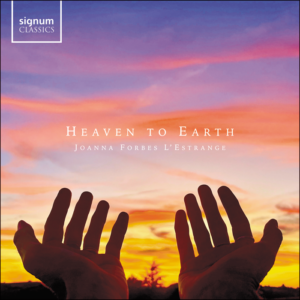
WILLIAM BYRD
***
BYRD: SACRED WORKS
Saint Thomas Choir of men and boys / Nicolas Haigh (associate organist) / Gerre Hancock (1981, The Great Service) / Jeremy Filsell ♦ Signum Classics 2CDs SIGCD776
A musical acquaintance of mine was rather sniffy about a recent release of music by William Byrd (c.1540–1623), arguing that the recording said ‘nothing new’. After 400 years since Byrd’s death perhaps nothing more can be added. Yet the choir of Saint Thomas Fifth Avenue, New York has made a good attempt with this double CD set that takes the Catholic Mass for the Feast of Corpus Christi of Byrd’s time as its over-arching structure.
Anyone who has tuned into the church’s YouTube channel will be aware of its strong Anglican Catholic tradition with excellent music and liturgy. This is an excellent starting point for this sonorous sequence that will be like manna from heaven for more traditional catholic tastes. Byrd’s works are used to provide music for Introit and Gradual, and Sacerdotes Domini is the Offertory motet. The Mass for Four Voices is the setting. The sequence ends with Communion motets such as Ave verum corpus and O sacrum convivium.
The second CD closes with movements from Byrd’s Great Service recorded in 1981 under the late Gerre Hancock. As Saint Thomas Fifth Avenue celebrates its bicentenary this year, it is a fine reminder of a long line of quality music making in the heart of Manhattan.
Stuart Robinson
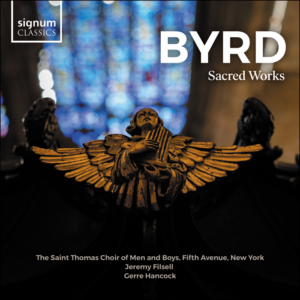
MASS SETTINGS
*
FILIPE DE MAGALHÃES: MASSES – VENI DOMINE & VERE DOMINUS EST
Cupertinos / Luís Toscano ♦ Hyperion CDA68403
LUDWIG DASER: MISSA PATER NOSTER & OTHER WORKS
Cinquecento Renaissance Vokal ♦ Hyperion CDA68414
From the ever-enterprising Hyperion label come two CDs of music that is likely to be unknown to most readers – indeed, both Masses by the Portuguese composer Filipe de Magalhães (c.1563–1652) are first recordings. The Missa Veni Domine, based on a motet by the Spanish Francisco Guerrero, and the Missa Vere Dominus est, based on one by the Flemish Pierre de Manchicourt, are varied in character with the former the more extrovert and the latter more introvert and reflective. Each Mass is preceded by a performance of the motet that provided its musical inspiration; one can clearly hear the melodic motifs reworked and elaborated by Magalhães throughout each movement. Between the Masses comes a performance of Magalhães’s Magnificat primi toni, through-composed and polyphonic in all verses. Throughout the disc (which also contains two six-part motets by Magalhães) the music shows why this composer was held in high regard by Portuguese musicians in the first decades of the 17th century. These confident performances by Cupertinos should help to re-establish his reputation 400 years later.
Ludwig Daser (1526–89) wrote for the Catholic Munich court and the Lutheran Stuttgart one. This CD, a wide-ranging introduction to his music, includes (as well as the Mass setting) Latin motets and German chorale settings. The five singers of Cinquecento make a strong case for a re-evaluation of a figure whose reputation has been largely overshadowed by Lassus, his successor at Munich.
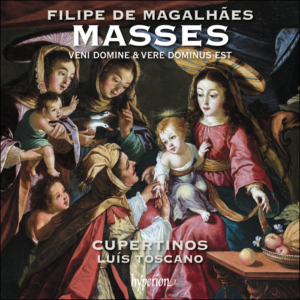
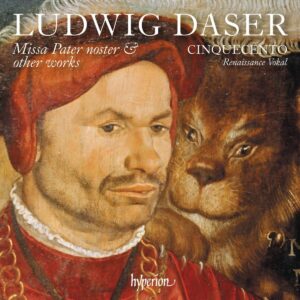
**
THE ARMED MAN: KARL JENKINS
Hertfordshire Chorus / Kathryn Rudge (mezzo-soprano) / Jamal Aliyev (cello) / Osama Kiwan (muezzin) / London Orchestra da Camera / David Temple ♦ Signum Classics SIGCD779
The music of this Mass setting with interpolations is based on the secular L’homme armé song, which itself was used as a cantus firmus in over 40 known Mass settings by Renaissance composers. Karl Jenkins’s music will need no introduction. This recording is the first using an ensemble version of the score. Choirs that have been put off by the size of the full band should certainly consider this smaller version, which, on this recording, preserves much of the impact of the original.
Judith Markwith

ORGAN CDs
***
A CELEBRATION: 40 YEARS AS BIRMINGHAM CITY ORGANIST
Thomas Trotter plays the organ of Town Hall, Birmingham ♦ Regent REGCD584
This excellent recording contains a rich mix of music that is clearly a celebration both of Trotter’s remarkable career and of the organ of Birmingham Town Hall. Parry’s Fantasia and Fugue in G opens the disc, and there are discoveries by William Wolstenholme, Kevin Volans and Rachel Laurin. An assured performance of Healey Willan’s Introduction, Passacaglia and Fugue provides the most substantial part of the disc. Trotter’s skill as an arranger for organ is clear for all to hear in his transcriptions of ‘Jupiter’ from Holst’s The Planets and of Eric Coates’s Knightsbridge March. Birmingham’s Mendelssohn connection is celebrated with his overture to St Paul. The Birmingham Town Hall organ is clearly in rude health; complete with Trotter’s beloved bells in Dring’s Caribbean Dance, it adds its own might and celebration of Trotter’s career in Birmingham. In the quieter dynamics of Wolstenholme’s The Question/The Answer and Karg-Elert’s Valse mignonne, the noise of the action does little to detract from the performance; in fact it contributes a special charm to this testament to a much-loved instrument and player.
Ian Munro
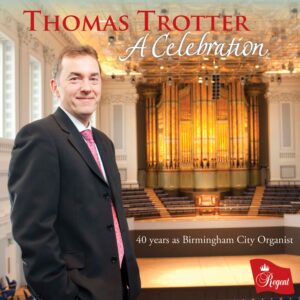
BOOKS
THE PIPE ORGAN: A COMPOSER’S GUIDE
James Mitchell
OUP 978-0-19-764529-1 £25.99
In recent years there has been an upswell in interest in composing for the organ as the instrument becomes increasingly popular in broad circles of musicians, listeners and contexts. Too often, though, composers stumble over the complexities and variety of instruments, either not getting the best effect or, worse, writing impractical or unplayable music. This manual, surprisingly the first one of its kind, is therefore most welcome. James Mitchell (a composer and organist formerly of Gloucester Cathedral) provides extensive information about the workings and functions of instruments, how to write idiomatically for manuals and pedals, registration advice, and practical thoughts on getting works performed.
The focus is a little conservative, which feels a bit like a missed opportunity given the current widening interest in the organ. The section on pedals is 30 pages long, but ‘extended techniques’ are dismissed, rather negatively, in just four; and there are just two paragraphs on combining the organ with electronics (a burgeoning field), including a highly debatable assertion that digital instruments are better in this context. Nevertheless, with its accompanying website, this is a treasury of information that will serve composers well as they explore the vast sonic possibilities of the organ.
Huw Morgan
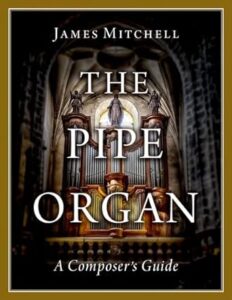
Reviews of printed music
E Easy
M Medium
D Difficult
EASTER AND PENTECOST
ON EASTER-MORN, ERE BREAK OF DAY [E/M]
arr. June Nixon
SATB and organ
Encore Publications 020750 £2.65
The traditional English carol melody is not well-known, but has a lovely, easy flow in this setting by June Nixon. The treatment is varied throughout the three verses, with an exciting climax shortly before the end. Recommended for concerts or as an Easter introit or anthem.
A BRIGHTER DAWN IS BREAKING [M]
Gail Randall
SSATB
Encore Publications 020754 £2.65
This is a reflective, atmospheric anthem for an Easter vigil or dawn service. The mood is mostly restrained, as if sensing the power of new life that comes with the breaking dawn. A move from E flat to C major heralds a fortissimo outburst on ‘Who now for ever livest’ before the opening mood returns.
OPEN MY HEART, ILLUMINE ME [M]
Richard Lloyd
SSA (or SSS) and organ
Encore Publications 020733 £2.75
Originally written for Richard Lloyd’s four daughters, and doubtless with expectation of a high standard of accomplishment, this plea to the Holy Spirit for illumination is a little trickier than it looks. The vocal lines, however, are beautifully shaped. David Hill’s 2016 Durham recording with The Bede Singers is currently available on YouTube (www.youtube.com/watch?v=7T87rDbDN8I) and well worth hearing to help assess whether this is a piece for your upper-voice choir.
James L. Montgomery
HYMN DESCANTS
MUSIC FOR ROYAL OCCASIONS [E]
CHRIST IS MADE THE SURE FOUNDATION [E]
James O’Donnell
SATB and organ
Encore Publications 020748 £3.95; 020762 £2.95
The first of these publications contains the descant settings that James O’Donnell wrote for Monks Gate for Prince Philip’s thanksgiving service and for St Clement and Blaenwern for Queen Elizabeth’s state funeral. It also contains the chant that O’Donnell wrote for Psalm 139, along with fully pointed psalm text, for the reception of the Queen’s coffin at Westminster Hall.
The separate publication of ‘Christ is made the sure foundation’ give us the tune Westminster Abbey, adapted from the final ‘Hallelujah’ section of Purcell’s O God, thou art my God, with the final descant heard at last year’s coronation. The accompaniment for trumpets, trombones, timpani and organ is available separately on sale, but the single organ part given in this vocal score makes a thrilling sound as its slow-moving bass line, starting at ‘consubstantial’, moves inexorably into the final Amen.
Stephen Patterson
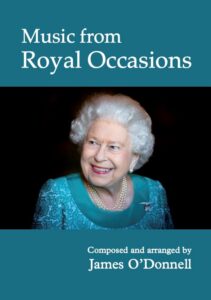
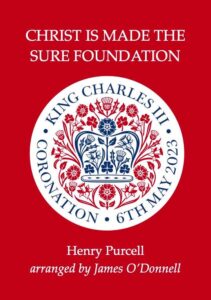
ANTHEMS
O SACRUM CONVIVIUM [M]
Ben Ponniah
SATB with divisions
Boosey & Hawkes BH14044 £2.25
O SACRUM CONVIVIUM [E/M]
Daniel Cook
SATB
Encore Publications 020751 £2.10
SACRUM–PROFANUM [D]
Romuald Twardowski
SATB with divisions
PWM Edition (Universal Edition) 12890 £11.50
Here are three totally different approaches to the same Eucharistic text. Ponniah moves homophonically in slow measured crotchets, with shifting harmonies centred on D flat. The whole piece is repeated, each time climaxing on ‘alleluia’ before a coda that repeats, reminiscent of Messiaen, the opening three words at half speed and ppp. The whole has a sort of hypnotic intensity.
Daniel Cook takes a more conventional approach, indeed sometimes approaching the feel of a Victorian partsong. It always has a clear sense of direction: harmonies and sequences lead the music firmly forward. This piece would be a good choice if you want to avoid a more mystical setting of the words.
At the time of his death earlier this year, Romuald Twardowski was the senior Polish composer of his generation, born in 1930, three years before Penderecki who had died in 2020. Unlike most of his fellow Polish composers, he wrote for the church throughout his life, Catholic and Orthodox. Sacrum–Profanum is a deliberate sacred-secular juxtaposition. The composer describes the contrasts experienced when there is secular fun and dancing outside a church, immediately after a service, with the two complementing each other – as do the two parts of this composition. The first part is a complete and intense setting of O sacrum convivium and indeed would work well as a stand-alone piece as it comes to a full cadence. Only the word ‘attacca’ serves to lead into the subsequent setting of 17th-century words that the composer describes as echoing an Italian saltarello.
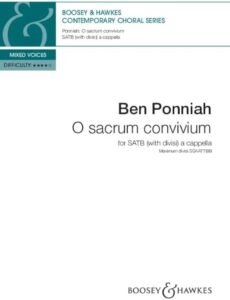
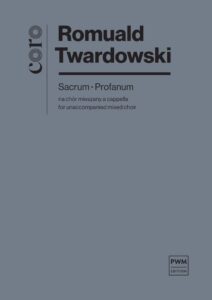
THE LORD’S PRAYER [E/M]
Esther Kay
SATB
Acuta Music 978-1-873690-21-5 £1.40
O GLADSOME LIGHT [M]
Esther Kay
SATB with divisions
Acuta Music 978-1-873690-22-2 £1.60
AVE MARIA [M]
Esther Kay
SSAA
Acuta Music £1.00
Here are three pieces by a composer with a keen ear for choral textures. The Lord’s Prayer was written to complement Humphrey Clucas’s set of responses, although Clucas himself has now provided that (published by FagusMusic and available from the RSCM Music Direct). However, the quiet introspection of this setting would fit well with other 20th-century settings. O Gladsome Light is a big setting with full, resonant chords and harmonies that seem to belong to an Anglican lineage from Stanford through Howells. Ave Maria is a surprise: an upper-voice dance, mostly light and fleeting. Perhaps it is intended to remind us that Mary was likely to have been in her early teens when the angel addressed her. At the start we are as surprised as Mary must have been; there is an ‘f sonore’ address to Mary as ‘Sancta Maria, Mater Dei’, and finally a dying away on ‘et in hora mortis nostrae’, all within an Animato tempo.
JUBILATE DEO [D]
Kim André Arnesen
SATB with divisions and organ
Boosey & Hawkes BH14039 £3.75
This is an exhilarating setting, in Latin, not of the whole text of Psalm 100, but just the first two verses before it veers off into verses from Psalm 57 starting ‘Cantabo, et psalmum dicam’ (‘I will sing and make music’). The rhythmic propulsion comes from Latin-American influenced rhythms (and a hint of Rutter’s Magnificat) that may be amplified by tambourine and drum; a percussion part is included at the end of the vocal score. Percussion is optional; a confident, rhythmically assured organist is essential.
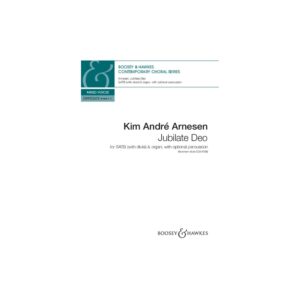
A CORNISH PRAYER [E]
Ashley Grote
SATB and organ
Encore Publications 020767 £2.65
Written to mark the retirement of Graham Jones as Bishop of Norwich, the words of the prayer (starting ‘I bring the faces I have seen, the voices I have heard’) could be appropriate not only at a retirement or other ‘moving-on’ occasion, but at the end of any day, or indeed at a funeral. The simple setting uses a tune that stays hauntingly in the mind, and harmonies that border but do not cross into sentimentality.
TANTUM ERGO [M]
Will Todd
SATB with divisions
Boosey & Hawkes BH14043 £2.75
Here is a meditative reflection on the Eucharistic hymn attributed to Thomas Aquinas, with almost chant-like repetition of gently pulsating chords. A series of ever-increasing crescendos eventually leads to a climax on ‘Procedenti ab utroque’ and the music relaxes into a series of final Amens. There is an optional organ part to support the texture if required.
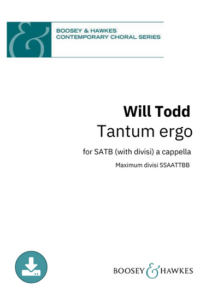
SIMPLE GIFTS [E]
arr. George Arthur
SS and piano
Universal Edition UE21844 £3.50
This setting of the Shaker song is appropriately simple, with two soprano parts mostly in canon at the unison and accompanied by piano. The tempo direction is ‘Simple and always warm’ and the warmth is provided by the piano chords. Overall the piece is short, sweet, easy and effective.
James L. Montgomery
SAINT-SAËNS
BY THE RIVERS OF BABYLON [M]
Camille Saint-Saëns ed. Christina Stahl
Alto solo, SATB choir and piano
Bärenreiter BA 11309 £9.00 [chorus score BA 11309-91 £5.50]
SUPER FLUMINA BABYLONIS [M]
Camille Saint-Saëns ed. Christina Stahl
Soprano solo, SATB choir and orchestra
Bärenreiter BA 11305-90 vocal score £7.00
Camille Saint-Saëns (1835–1921) made four separate versions of his setting of Psalm 137. We have here his final setting with English words, dating from the 1870s or 80s, and also a vocal score of his first version, in Latin, from 1854 with accompaniment of strings, saxophone quartet and organ. The vocal score of this Latin version has a piano accompaniment by the composer.
It is the final English-texted version that will be of most interest to Sunday by Sunday readers. This is a ten-minute through-composed cantata setting the nine verses from the King James Bible, with a repetition of the opening verse at the end. Alto solo and chorus alternate with much dramatic illustration of the text before a large-scale final chorus ‘O daughter of Babylon’. The whole work is an oddity, perhaps, but in length and also level of difficulty it would be well within the capability of English-speaking church choirs.
Stephen Patterson
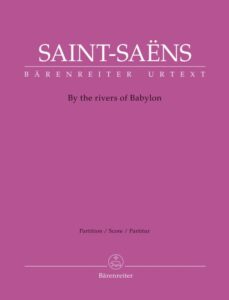
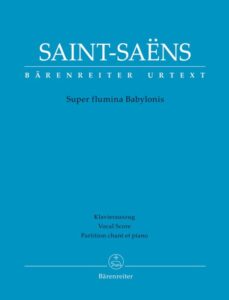
ORGAN MUSIC
E Easy
M Medium
D Difficult
MANUALS ONLY
SIX ORGAN CONCERTOS BOOK 2 (Nos. 4–6) [D]
Georg Christoph Wagenseil
David Patrick
Fitzjohn Music Publications FMP226 £13.00
I reviewed in Sunday by Sunday 106 (September 2023) the first three concertos by Georg Wagenseil (1715–77) of the set of six published by Walsh in London, c.1761. David Patrick has now published the remaining three in C, G and A. Each concerto is in three movements, the opening movement being through-composed, headed Allegro, Allegro Moderato and Vivace respectively. Number five is in 2/4, the other two in common time, and they also have figures beneath the bass.
Central movements, also through-composed, are in the tonic minor in each concerto. Those of numbers four and five are marked Andante and are in 3/4 and common time respectively; that of number six is marked Larghetto and is in cut common time and has a figured bass. These movements are full of the Empfindsamkeit associated with C.P.E. Bach and his followers.
The closing movements are in the tonic major, marked Allegro in numbers four and five, and Tempo di Minuet in number six. All are in 3/8 with plenty of rhythmic variety, including semiquaver triplet, demisemiquavers and even hemidemisemiquaver scalar runs, precluding too fast a tempo to ensure clarity. There are repeated sections in number four; number six is in binary form. These final movements are figured to some extent.
There are numerous dynamic indications, indications of Tutti and Solo, and occasional bass notes below modern compass: for all of these, players must work out their best solutions. Quite demanding to play, and difficult to execute their rapid dynamic changes cleanly even when changing manuals, these pieces are rewarding for those who persevere.
John Collins
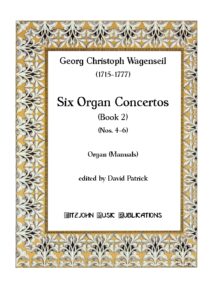
MAX REGER
CHORALFANTASIEN I (Op. 27, 30, 40/1&2) [D]
CHORALFANTASIEN II (Op. 52/1–3) [D]
Max Reger ed. Martin Schmeding
Edition Peters EP11591, EP11592 £17.95 each
It is not uncommon for new editions to appear during the year of a composer’s anniversary, and 2023 is certainly no different. The 150th birthday of Max Reger (1873–1916) is on 19 March, and Martin Schmeding and Edition Peters have celebrated this with the release of a new edition of Reger’s Choralfantasien.
Max Reger composed his seven chorale fantasias – based on Lutheran hymns – within the space of two years, between August 1898 and October 1900. They concluded his preoccupation with large-scale forms, and Reger considered them to be among his finest compositions.
In this much-needed edition, which is accompanied by an erudite preface, timeline of composition, and detailed commentary for each work, we finally have a clear score which takes into consideration original source materials, and which in turn have sought to eliminate some of the ambiguities that have typically crept into earlier editions. Despite the many notes (typical of Reger!), the engravings are very clean, ensuring one’s ability to decipher easily even the most concentrated passages.
These are fine editions, deserving of a place on the music shelf of any serious organist.
Richard Brasier
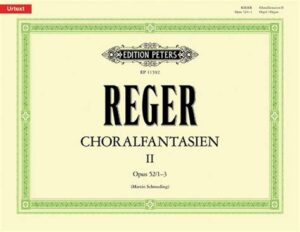
VOLUNTARIES
AN ORGANIST’S SCOTTISH COLLECTION BOOK 2: NATIONAL MELODIES [M]
arr. Antony Baldwin
Banks Music Publications 14142 £8.50
Following quickly on from volume 1, Antony Baldwin has arranged a further 22 Scottish traditional melodies and assembled them into this attractive collection. Several melodies, including Reres Hill, The Flower of the Quern, Tramps and Hawkers and Bonnie Prince George Campbell, are included in hymn arrangements in Church Hymnary 4 (the hymn book of the Church of Scotland), therefore allowing a short prelude before playing one of the hymn settings. Other pieces include Scots Wha Hae, Scotland the Brave, Wild Mountain Thyme and many others which will be more widely known. Ideal for recitals, funerals or weddings, this is a worthwhile collection for any organist to keep within easy reach. The arrangements are slightly more advanced than the first volume but not to an intimidating level. Neatly set out and expertly typeset, this is a much welcome addition to the collection!
Ian Munro
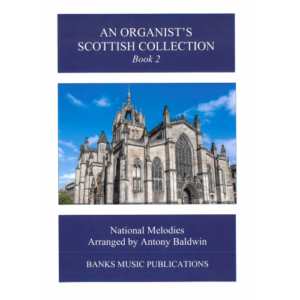
INTAGLIO [M]
Frederick Frahm
BEATA VISCERA [M]
Huw Morgan
Firehead Organ Works FH-358, FH-350 £7.92 each
Avoiding the temptation of publishers to show caution in their organ music publishing, Firehead continue to distribute a stylistically wide range of new compositions, although only for purchase and download online. The music of US composer Frederick Frahm has been championed by Carson Cooman who describes how ‘Shapes and forms are articulated and etched with precision. Juxtaposition and repetition create a dialogue in time between the musical blocks that comprise a Frahm piece.’ This is clearly seen even in a short piece such as intaglio (literally ‘etching’ or ‘engraving’), where short, characterful themes are repeated and juxtaposed in a rondo-like ABACA structure. It is an appealing work with a main ‘A’ section that seems to dance and made me smile on each repetition. However, to make sense of the two-stave score it is essential to read the composer’s note ‘On performing “intaglio”’ that appears only to be available at https://fireheadorganworks.com/tag/lily-michael/ and covers the use of the pedals (essential in at least one place), registration, pauses and much more, and also shows the etching by Lily Michael that inspired the piece.
Huw Morgan’s Beata viscera, written for Francis O’Gorman, has some of the feeling of a medieval dance, and indeed is based on motifs from Pérotin’s 13th-century Marian motet of the same name. As with the Frahm piece, there is a fascinating essay by the composer ‘Composing and performing Beata Viscera’ along with a link to a recording that is worth exploring at https://fireheadorganworks.com/composing-and-performing-beata-viscera/. It is a pity that there is no obvious link to these essays on the shopping page for each title – it is worth making the effort to find them, and may well inspire organists to programme these attractive and comparatively easy works.
Julian Elloway
WORKS FOR ORGAN [mostly M]
Vincent d’Indy ed. Otto Depenheuer
Edition Dohr 20488 (Universal Edition) £9.50
Organists who do not already have copies of the organ music of Vincent d’Indy (1851–1931) may find this single volume a useful and reasonably priced publication. The composer only wrote three organ compositions, although the Op. 51 Vêpres du commun des Saints comprises eight separate antiphons based on Gregorian chant melodies. The Prélude Op. 66, dedicated to Louis Vierne, is an impressive piece as presented here in its 1913 three-stave version. The volume starts with the Prélude et Petit Canon Op. 38 in which the prelude appears twice, the second time in inversion, and also includes an arrangement by Otto Depenheuer of Petite chanson grégorienne Op. 60, originally for piano duet and rightly described by the editor as a striking miniature.
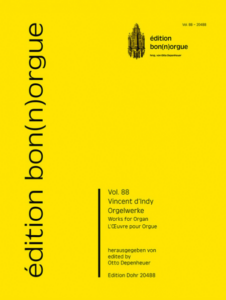
SONATA FOR THE ORGAN; A SECOND SONATA [M/D–D]
Francis Edward Gladstone ed. Iain Quinn
Ut Orpheus (Universal Edition) HS318 £17.95
Francis Gladstone (1845–1928) was cousin of the Victorian prime minister and pupil of S. S. Wesley. His attention to detail and thoughtful preparation can be seen in these scores; an obituary observed that ‘it was exactly like him, not only to have written the composition for his own funeral but to have coached the monks beforehand who were to sing it.’ The first of the sonatas, dating from 1879, could be described as being in the Mendelssohn tradition and is less difficult than the second that was written in 1915 after his retirement from a series of cathedral, church and academic appointments. The editor, Iain Quinn, notes that the first does not have a fugal final movement that would have been expected at the time. The second sonata’s last movement, however, includes a fugue with a plainchant fugue – perhaps reflecting Gladstone’s conversion to Roman Catholicism between the composition of the two sonatas. The edition is the fourth in Ut Orpheus’s English Organ Sonatas series (see SbyS 97, June 2021 for the previous volumes) and maintains the same exemplary standards of editing and presentation.
Duncan Watkins
